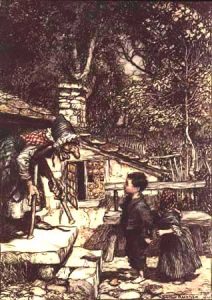How Fairytales Can Deepen Themes in Our Writing
 When I was little, my mother read me fairytales. I remember Andrew Lang’s books, The Tall Book of Fairytales, and a peculiar story about a girl who jumped rope and could skip through a key hole and light as a feather on dandelion thistle. It took me years to track down Elsie Piddock Skips in Her Sleep, again.
When I was little, my mother read me fairytales. I remember Andrew Lang’s books, The Tall Book of Fairytales, and a peculiar story about a girl who jumped rope and could skip through a key hole and light as a feather on dandelion thistle. It took me years to track down Elsie Piddock Skips in Her Sleep, again.
My father told a different kind of story. Especially when he was drinking. He told stories of surviving alone on the streets of Brooklyn as a ten year old flu orphan, about stealing food from Wallabout Market and hoping for the kindness of strangers. These were the stories that haunted his life.
It took me years to see the connection between the two types of stories I grew up with, and it was a fairytale, specifically Hansel and Gretel, that helped make that link. As I wrote my YA historical novel Between Before and After, I realized that the theme of survival and eventual redemption in my novel was intimately tied to Hansel and Gretel, and in a risky move, I wove a retelling of the fairytale between the chapters.
In Fairytales, the woods are dark and dangerous places where anything might happen. There are many tales of children lost, abandoned, or sent into the woods at the request of a parent or evil stepmother. Author and fairytale expert Terri Windling put it this way in her blog post Into the Woods,10: Wild Children: “The heroism of such children lies … in the ability to survive and transform their fate — and to outwit those who would do them harm without losing their lives, their souls, or their humanity in the process.” No one leaves the mythic woods unchanged. This is a truth I wanted to capture in my own novel.
 Between Before and After is a mother daughter dual narrative set in 1919 Brooklyn, New York and 1955 San Jose, California. In researching my novel I discovered that in late 1800’s New York, up to 30,000 abandoned or orphaned children filled overflowing orphanages or lived on the streets. This vast number of orphans was due in part to the overwhelming number of destitute immigrants living in crowded tenements.
Between Before and After is a mother daughter dual narrative set in 1919 Brooklyn, New York and 1955 San Jose, California. In researching my novel I discovered that in late 1800’s New York, up to 30,000 abandoned or orphaned children filled overflowing orphanages or lived on the streets. This vast number of orphans was due in part to the overwhelming number of destitute immigrants living in crowded tenements.
By 1900 there were 16 million Irish immigrants alone. During these years, childbirth was still the number one cause of female mortality, leaving impoverished fathers with young children.
Then the Spanish flu arrived with its scythe and black cloak.
Many children became half-orphans, abandoned by one parent after the other died. For these children, the streets of our cities were the woods of the grimmest fairytales, dark, full of predators and danger.
Against all odds many of these immigrant children survived their sojourn through the woods without losing their humanity. Many, of course, did not. Surviving childhood is not always easy nor is it guaranteed. And that’s what the fairytales have warned us about all along.
This is my family’s story, but it’s the story of thousands of children who have had to follow breadcrumbs on perilous journeys to find their way home.
What is it about fairy tales that compels us, that resonates with the themes in our own lives?
JRR Tolkein in his magnificent essay “On Fairy Stories” talks of the eucastic turn or happy ending. The fairy story “denies universal defeat…giving a fleeting glimpse of Joy. Joy beyond the walls of the world, poignant as grief.” While fairy tales acknowledge and warn us of the existence of evil, they never pretend that evil is good or that despair has the final word. Fairy tales persist because in their themes, they tell us truths about the world.
The world is not a safe place: Myth reminds us that world is not a predictable and safe place. Fairies leave changelings, labyrinths hide monsters, shapeshifters cast spells. The mythic world is never tame.
There is no easy way out of the maze: when Theseus finds his way to the heart of the maze, he still must battle the minotaur, birds eat breadcrumbs, dragons swoop in, and we must travel through the dangers.
We often fear the wrong things: We fear outside enemies, but it’s our own greed, jealousy and hubris that most often cause our downfall.
We are all more than meets the eye: The reluctant hero discovers strengths she never knew she possessed.
We can fight dragons and win: As G.K. Chesterton says, “Fairy stories are more than true, not because they tell us there are dragons, but because they tell us dragons can be defeated.”
All stories are about transformation: no one leaves the woods unchanged. Without change, there is no story.
Children still struggle in the woods today. Some are still locked in the witch’s house by parents’ addictions, cruelty, or dire circumstances. There is still a need for tales of hope, stories that say circumstances no matter how dark need not define you.
About Maureen McQuerry
Maureen McQuerry is an award winning poet, novelist and teacher. Her YA novel, The Peculiars (Abrams/Amulet) is an ALA Best Book for YA 2013, winner of the Westchester Award. Her MG fantasy duo Time Out of Time, includes Beyond the Door, a Booklist top Ten Fantasy/SciFi for Youth, and The Telling Stone, a finalist for the WA State Book awards. Between Before & After(HarperCollins/Blink) will be released in Feb 2019.
She taught middle school through college for almost twenty years. She currently supervises student teachers for WSU. When she’s not writing she hiking, playing with her grandson and looking for the next real life mystery to solve.
Find out more: www.maureenmcquerry.com
https://www.instagram.com/maureenmcquerry/
https://twitter.com/maureenmcquerry
About BETWEEN BEFORE AND AFTER
“The carnage began with the roses. She hacked at their ruffled blooms until they dropped into monstrous drifts of red on the parched yellow lawn … Only two things kept my mother grounded to us: my uncle Stephen and stories.”
Fourteen-year-old Molly worries about school, friends, and her parents’ failed marriage, but mostly about her mother’s growing depression. Molly knows her mother is nursing a carefully-kept secret. A writer with an obsession for other people’s life stories, Elaine Donnelly is the poster child of repressed emotions.
Molly spends her California summer alternately watching out for her little brother Angus and tip-toeing around her mother’s raw feelings. Molly needs her mother more than ever, but Elaine shuts herself off from real human connections and buries herself in the lives and deaths of the strangers she writes about. When Uncle Stephen is pressed into the limelight because of his miracle cure of a young man, Elaine can no longer hide behind other people’s stories. And as Molly digs into her mother’s past, she finds a secret hidden in her mother’s dresser that may be the key to unlocking a family mystery dating to 1918 New York—a secret that could destroy or save their future.
Told in dual narratives between 1918 New York City and 1955 San Jose, California, Between Before and After, by award-winning author Maureen McQuerry, explores the nature of family secrets, resiliency, and redemption. This is an historical coming-of-age Young Adult story about the complex bonds between mothers and daughters.
Category: Contemporary Women Writers, On Writing

























I really liked this post. I hadn’t realized there were so many orphans at the end of the 1800s. Wow.
Love your post as themes of lost children also run through my work and fairy tales had a great impact on me as a child. My mother actually used Snow White to explain death. I was very young, but the connection helped. Wishing you the best with you work, Beth Havey
Thanks, Beth. We are both blessed to have mothers who read to us and who read us fairy tales!